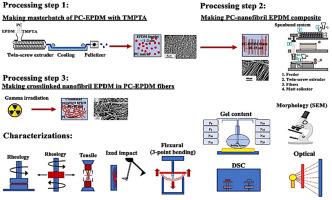Elevating Polycarbonate Performance: Exploiting In-situ Nanofibrillated and Crosslinked Ethylene Propylene Diene Monomer Networks to Achieve Superior Material Properties
IF 4.5
2区 化学
Q2 POLYMER SCIENCE
引用次数: 0
Abstract
The incorporation of an elastomer into polymer composites is a widely employed method to enhance toughness; however, this often results in the sacrificed crucial matrix properties, such as stiffness and strength. In this study, an efficient composite technology is presented for enhancing the toughness of polycarbonate (PC) with a marginal sacrificing of stiffness and strength. Initially, PC-spherical ethylene propylene diene monomer (EPDM) blends were prepared using a twin-screw extruder (TSE), followed by a hot stretching process in a spunbond system. The produced PC microfibers containing EPDM nanofibrils were exposed to gamma radiation to effectively crosslink EPDM through ethylidene norbornene (ENB) and thereby preserve the nanofibril geometry, while crosslinking the PC phase slightly. Morphological observations of the reheated blends revealed a well-dispersed, crosslinked nanofibrillar EPDM network within the PC matrix, featuring an average diameter of 40-80 nm. Our study investigates the influence of EPDM nanofibril size and content on PC composites. We found that incorporating nanofibril EPDM significantly improves toughness compared to spherical EPDM phases, with over 300% increase in elongation at break and over 200% increase in Izod impact strength. These findings highlight the efficacy of nanofibril EPDM in advancing PC's mechanical properties, offering promising prospects for polymer engineering. The transparency of PC was maintained with the presence of nanofibril EPDM, making it suitable for various transparent applications.

提高聚碳酸酯性能:利用原位纳米纤化和交联乙丙二烯单体网络实现优越的材料性能
在聚合物复合材料中加入弹性体是一种广泛采用的增强韧性的方法;然而,这通常会导致牺牲关键的基体特性,如刚度和强度。在这项研究中,提出了一种有效的复合技术来提高聚碳酸酯(PC)的韧性,同时牺牲刚度和强度。首先,使用双螺杆挤出机(TSE)制备pc -球形三元乙丙橡胶(EPDM)共混物,然后在纺粘系统中进行热拉伸。将含有EPDM纳米原纤维的PC微纤维暴露在伽马辐射下,通过降木片烯(ENB)有效地交联EPDM,从而保持纳米原纤维的几何形状,而PC相则轻微交联。再加热共混物的形态学观察显示,在PC基体中有一个分散良好的交联纳米纤维EPDM网络,其平均直径为40-80 nm。研究了三元乙丙橡胶纳米纤维的尺寸和含量对PC复合材料性能的影响。我们发现,与球形EPDM相相比,加入纳米纤维EPDM显著提高了韧性,断裂伸长率提高了300%以上,Izod冲击强度提高了200%以上。这些发现突出了纳米纤维EPDM在提高PC力学性能方面的功效,为聚合物工程提供了广阔的前景。纳米纤维EPDM的存在保持了PC的透明度,使其适用于各种透明应用。
本文章由计算机程序翻译,如有差异,请以英文原文为准。
求助全文
约1分钟内获得全文
求助全文
来源期刊

Polymer
化学-高分子科学
CiteScore
7.90
自引率
8.70%
发文量
959
审稿时长
32 days
期刊介绍:
Polymer is an interdisciplinary journal dedicated to publishing innovative and significant advances in Polymer Physics, Chemistry and Technology. We welcome submissions on polymer hybrids, nanocomposites, characterisation and self-assembly. Polymer also publishes work on the technological application of polymers in energy and optoelectronics.
The main scope is covered but not limited to the following core areas:
Polymer Materials
Nanocomposites and hybrid nanomaterials
Polymer blends, films, fibres, networks and porous materials
Physical Characterization
Characterisation, modelling and simulation* of molecular and materials properties in bulk, solution, and thin films
Polymer Engineering
Advanced multiscale processing methods
Polymer Synthesis, Modification and Self-assembly
Including designer polymer architectures, mechanisms and kinetics, and supramolecular polymerization
Technological Applications
Polymers for energy generation and storage
Polymer membranes for separation technology
Polymers for opto- and microelectronics.
 求助内容:
求助内容: 应助结果提醒方式:
应助结果提醒方式:


